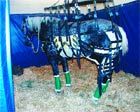CSU studies WNV survival rate
Fort Collins, Colo.-Vaccination did improve West Nile Virus survival rates last year in equines from Colorado and Nebraska, according to a Colorado State University study. However, not enough horses may have received the vaccination, the study notes.
Fort Collins, Colo.-Vaccination did improve West Nile Virus survival rates last year in equines from Colorado and Nebraska, according to a Colorado State University study. However, not enough horses may have received the vaccination, the study notes.

Stricken with West Nile Virus, a 7-year-old gelding admitted to CSU had to be supported with slings because he was unable to stand on his own. He was not vaccinated, but did recover.
Lead investigator Dr. Josie Traub-Dargatz said she was less surprised about the effectiveness of the vaccine than she was to learn that the vast majority of the randomly selected horses in the unprecedented two-state study had not been vaccinated.
Of the approximately 580 horses that the Colorado State University epidemiologist and her associates evaluated, only 13 were fully vaccinated according to the manufacturer's recommendation.
The silver lining: of those 13 in the study, at least 12 survived; the other horse's status was unknown. By comparison, the estimated fatality rate for nonvaccinated, infected horses from both states is 28.6 percent, researchers say.
"The study's results give us a clearer picture of last summer's outbreak, especially in terms of the numbers of horses affected that were unvaccinated or incompletely vaccinated as well as their survival rate," adds Traub-Dargatz of the CSU College of Veterinary Medicine and Biomedical Sciences.

Dr. Josie Traub-Dargatz inoculates a horse with the West Nile Virus vaccine. Kim Ellis, a lab technician, assists.
Pro-vaccine?
Dr. Tricia Salazar, CSU research associate, helped to author the study. While hedging a ringing endorsement for the WNV vaccine, manufactured by Fort Dodge Animal Health, she notes "Even horses that had not received both doses of vaccine several weeks prior to exposure to West Nile Virus were more likely to survive than those that were non-vaccinated."
Adds Traub-Dargatz, "This is really good evidence that this is a disease that deserves prevention."
While neither investigator would outright promote the horse vaccine, which was recently fully approved by the USDA, the research indicates that the vaccine can improve survival rates among horse populations.
Researchers found a 20 percent fatality rate among infected animals that had received one shot of West Nile Innovator vaccine, half the recommended dose. When horses received the initial vaccination and the recommended booster shot six weeks later, survival rates climbed to 12 of every 13 horses.
Core value
The objective of the study was to describe the equine WNV cases in the two states to establish the progression of the clinical disease, clinical signs and clinical outcome.
Cases included in the study were selected at random out of the 1,500 cases in Colorado and Nebraska.
The most common clinical sign associated with WNV infection identified in the study was an altered gait, including: reluctance to move; stumbling; perceived lameness; ataxia or weakness.
Whether the study's vaccination statistics would reflect those of other states, Traub-Dargatz would not guess. She does note, however, that the case fatality rate is close to what's been reported in other states.
The estimated case fatality rate for affected horses in Colorado and Nebraska was 28.6 percent, similar to reports from other regions of the United States.
Phone duty
Traub-Dargatz and Salazar largely credit honors students for their diligence, persistence and weekend hours devoted to contacting more than 500 owners of affected horses to pool data about their individual circumstances.
"We were able to enlist the assistance of about two dozen Colorado State veterinary students to help us draft a survey, make calls to horse owners and gather the details about their cases to analyze," says Salazar.
The study was a collaborative effort between the state veterinarians in Colorado and Nebraska, the Veterinary Diagnostic Center in Nebraska and Colorado State University's College of Veterinary Medicine and Biomedical Sciences.
But student involvement proved critical to the execution of the study. "The state veterinarian's offices had the client contact information on these cases but lacked the staff time to follow up with inquiries about areas such as vaccination status and treatment."
The entire report can be viewed and/or downloaded at ftp://ftp.communications.colstate.-edu/westnile.doc or from the university's Animal Population Health Institute Web site at www.cvmbs.colostate.edu/aphi.